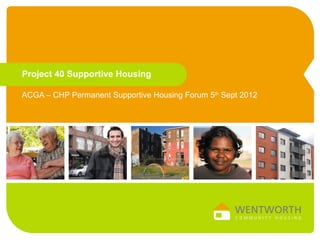
Project 40 Supportive Housing
- 1. Project 40 Supportive Housing ACGA – CHP Permanent Supportive Housing Forum 5th Sept 2012
- 2. Acknowledgement of Country We’re meeting on Aboriginal land and we acknowledge the traditional owners of that land, the Kulin nation. We pay respects to all Elders, past and present, and to the Ancestors. We acknowledge the strength and resilience of our Aboriginal brothers and sisters and what they have taught and continue to teach us.
- 3. Project 40 & Wentworth targets most vulnerable • Project 40 provides supportive housing for most vulnerable chronically homeless • Data - rough sleepers & Aboriginal people most at risk of early death • Mainstream services largely inaccessible to both these marginalised groups
- 4. Australian Homelessness • 18% of total homeless population are rough sleepers • 20% are Aboriginal or Torres Strait Islander • 28% of all homeless children are Aboriginal or Torres Strait Islander despite the fact that they represent only 5% of all Australian children • 59% of people needing accommodation are turned away from homeless services SAAP National Data Collection annual report 2010-11
- 5. Project 40 – Supportive Housing Tenancies - as at August 2012 tenancies Adults Children Aboriginal 15 17 29 Other 26 51 60 TOTAL 41 68 89
- 6. Allocation according to vulnerability not advocacy • Coordination Groups comprising 20-25 mainstream and specialist agencies allocate SH packages in each of the 4 LGA’s • At beginning (2010) CG’s allocated according to advocacy • In 2011 implemented Vulnerability Index ranking based on Dr Jim O’Connell’s research so allocated according to vulnerability
- 7. Vulnerability Factors of Project 40 Number Adults % Tenants (as at August 2012) (out of 45total) Drug & Alcohol abuse 26 58% Mental Health issues (diagnosis of schizophrenia 37 82% spectrum, bipolar, depressive etc) Dual Diagnosis 22 49% Aboriginal or Torres Strait Islander 16 36% Violence 39 86% Trauma 37 84% Chronic medical 5 14% Chronic homelessness 43 97% Institutions (prison or out of home care) 20 45% Disability 4 11%
- 8. Chronic Homelessness Down and Out in Western Sydney 1 Greater Western Sydney •Population of 1.9 million Nepean-Blacktown region (outer Western Sydney) •Population of 521,000 •Covers 4,679 square kilometres •World Heritage National Park •Comparison to inner city Sydney which has population of 177,000 & covers 26 square kilometres •Highest concentration of urban Aborigines in Australia
- 9. Down and Out in Western Sydney 2 Chronic homelessness •Rough sleepers – rivers, caves, National Park, bush, cars, trains •Women – cars and exploitative situations •Families – cars & tents •Young people – squats & couch-surfing •Aboriginal people – overcrowding & living in the bush No funded services for rough sleepers •No hostels, shelters, outreach or support Vulnerability Index Survey •Of the 14 people ranked as most at risk of dying on the street, 10 were Aboriginal
- 10. Project 40 – Supportive Housing Issues for rough sleeping people & families • Invisible to society and services • History of trauma • Violent attacks on a regular basis • Chronic medical conditions • Addiction issues • Mental health issues • untreated and undiagnosed
- 11. Project 40 – Supportive Housing Issues for Aboriginal people • Impact of Stolen Generations • parenting and family functioning • Grief and Loss • Overcrowding • Over-represented in prison populations • men and women • post-release issues • Loss of children into care • Barriers to mainstream services • inflexible and culturally insensitive • Racism experienced on a daily basis
- 13. Uncle Dallas’ Story I was homeless…sleeping in the National Park… Some kids that knew I was sleeping there burnt my shack – it was all totally burnt. I thought I was looking at the end of my life. There was a time when life was good. I had a job and a home… I couldn’t afford the mortgage so the bank foreclosed. Being a religious and spiritual person, Project 40 answered my prayers… Before this I couldn’t see much point in living.
- 14. Cultural Safety
- 15. Smoking Ceremony & Uncle Wes Marnes
- 17. Edna’s Story Having our own place has been good for me and the children. They are happy and they like their school in Riverstone. Before we got this house we didn’t have a home. We were staying with my niece, the six of us sleeping in one room. I was stressed but now I feel a big relief. I am closer to family and we are healthier.
- 18. Project 40 – Supportive Housing